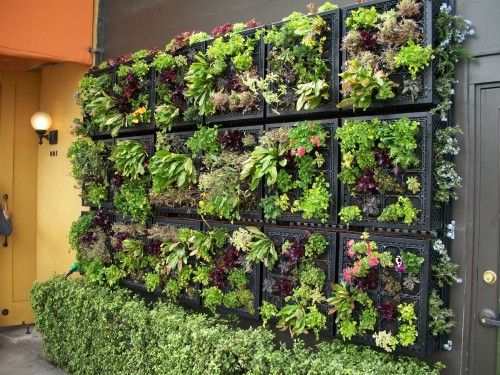Vertical green spaces have been touted as a possible solution to heat stress and hunger. [Picture: Gardenstead]
It is as if the scorching Sun is suspended at an arm’s length above the sprawling concrete jungle that is Johannesburg. Between work, study and pollen-induced fits of sneezing, I reach out for my water bottle. It’s three-quarters empty, and in a minute I will sprint off to refill it.
Yet my experience of this heatwave is very different from anything experienced by inhabitants of the nearby informal settlement, just a kilometre down the road from my air conditioned suburban home.
While heatwaves are no unusual occurrence in this part of the world, they certainly are getting more intense.
“Climate change is a serious issue for cities, particularly in Africa where you have significant inequality in cities,” says Professor Olumuyiwa Adegun, a visiting senior lecturer at the University of the Witwatersrand in Johannesburg.
I first connected with Adegun when he and a colleague at the Federal University of Technology in Akure, Nigeria, conducted a study on heat stress among residents of Lagos, Nigeria.
Worryingly, he says, an absence of basic infrastructure creates a “double tragedy” for people living in informal settlements on the periphery of large urban centres like Lagos and Johannesburg.
SMread: New book will show you how to make your money work for you
Vertical green spaces
They investigated the suitability of vertical green spaces as a method of adapting to heat exposure in cities. Basically, growing plants on buildings.
Made of high-density polyethylene pipes, it turns out they make an excellent solution for both informal settlements and affluent areas – and the benefits extend beyond addressing heat stress.
“Vegetation, naturally, helps to reduce the ambient temperature. They soak in heat [and] provide shade,” he says. “It’s one of the solutions, not just for the poor areas but also for the affluent areas.”
The prototypes were installed in dozens of homes in Lagos, Nigeria, and Dar-es-Salaam, Tanzania. Adegun and his colleague ensured local plants were grown in either case, and the results were marvellous.
“We engaged people on how it was useful … and confirmed in our findings that they got their vegetable staple from these farms. It’s subsistence as it’s something just for the family; it wasn’t so much that they could sell, from our small experiment anyway,”
The prototypes may not have harvested cartfuls of vegetables, but they yielded enough to give a taste of what a scaled-up rollout could offer. In Nigeria, a typical unit harvested around 1kg in a six-week cycle. It fed mouths and saved money.
“It was very useful in providing food. What they would have spent buying vegetables would be saved income.”
SMread: Fighting for a just peace in Palestine
Challenges
Of course, vertical green spaces are not the silver bullet that will mitigate heat stress and eradicate hunger in one go. Adegun and his colleagues noted several challenges, but none too big an obstacle.
A recurring difficulty was that many residents had forgotten to irrigate their plants. “Some feel they’re so busy, they forgot to water the plants or they don’t have time to water the plants.
There might have been concerns about the structural integrity of the buildings once vertical gardens were affixed, but the lightweight nature of the prototype turned out just fine.
“Some of the buildings were not originally designed to take on these structures, but what we designed was quite lightweight so it didn’t make any significant difference structurally.”
Call the pest control services, though, because some participating households in the pilot project found that “it attracts insects [and] potentially brings rodents”.
“They are manageable with improved awareness, with patience and as it gains traction I think some of those challenges can be addressed.
SMread: Healing is a missing goal in the UN SDGs
Opportunities
If the challenges can be overcome and the concept gains traction, Adegun foresees several benefits for households. Each unit is lightweight and costs around 100 USD (R1 893..20). There is potential to roll it out on a larger scale, he says, and deliver the benefits to many more.
“It’s something you can do and compared to the kind of vegetables you get in the long-run, over the years, it’s something worthwhile. What we really look forward to is scaling it up to optimise profits. Not just for someone who wants to do it and get vegetables for [their] family, but someone can do it and get vegetables to sell and make profit,” he says.
Even as the world battles global warming with a number of policies, theories and regulations, he is confident vertical green spaces have much to offer.
“Whether you’re doing it indoors or you’re doing it outside, it contributes to the quantity of green spaces in the environment, so it’s a way to go,” he says, adding, “Everyone has a role to play. If it’s an individual who wants to do it, fine. If it’s a family, good. If the government feels they want to roll out prototypes, that’s also possible.
After having created interest – at least in Nigeria and Tanzania – Adegun is excited to see how the idea can spread across the continent.
“As settlements grow and they densify, you have less land to do green stuff. Can’t we begin to do it vertically since we wouldn’t have enough land? Let’s begin to do it vertically. I think there’s a lot more to do, a lot more impact we’d love to see,” he says.
